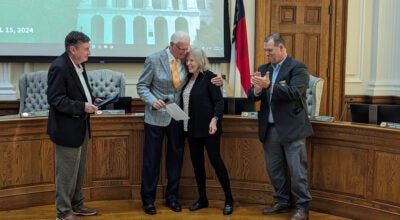Message of hope on economy, environment
Published 12:00 am Saturday, January 22, 2011
By Kathy Chaffin
Center for the Environment
Environmental Defense Fund President Fred Krupp and EDF staff member Miriam Horn delivered a rousing message of hope for the environment — and the economy — at Catawba College Thursday evening.
In the year and a half since the revised paperback version of their book, “Earth: The Sequel,” came out, Krupp told the 300 people gathered in Keppel Auditorium that the clean energy revolution — a multi-trillion-dollar market — predicted by their book is here and well under way.
“It’s a revolution that has made our air cleaner,” he said, “and in doing so, it has made us healthier. It’s a revolution that can create millions of American jobs. It’s a revolution that can help free the country and lessen our dependence on imported oil.
“It’s a revolution in my view … and for all these reasons, I think America is well positioned to lead because of our spirit as an entrepreneurial people, because of our innovativeness and, to me and I hope to you, it’s a revolution that you agree we’ve got to work hard to make sure that America does lead the world in making these new technologies come about to help make our world a better place.”
The program was sponsored by the Center for the Environment, located on the Catawba campus. Dr. John Wear, Center executive director, in introducing Krupp and Horn, announced that a climate core intern from the Environmental Defense Fund (EDF) will be working with center staff this summer.
“We are proud as John mentioned … that an EDF climate core intern is coming here to Catawba,” Krupp said. The EDF has placed 52 MBA students in internships in companies across the country, he said, and at every single location, they identified ways to save “massive amounts of money” by becoming more energy efficient.
Krupp, who has headed the EDF for 26 years, said his staff in the Raleigh office has worked with three North Carolina universities to figure out ways they can save $38 billion by becoming more energy efficient.
Horn, director of the Smart Grid Initiative for the EDF, described a future where a smart grid infrastructure will communicate with devices all across the grid and ask them to turn down or off during times of peak demand, saving energy and lowering the cost for everyone. “It can talk to Walmart and ask them to turn down their lights,” she said. “It can talk to refrigerators in everybody’s homes and ask them to delay defrosting …”
Horn — a former journalist who worked for Vanity Fair, The New York Times, The New Republic and U.S. News and World Report — said the grid will also communicate with electric cars so that they will alternate charging times.
The intelligence built into every component of the grid will also allow consumers to sell energy and make money. “Your dishwasher will be able to day trade electricity for you …” she said, “and your solar panels will be talking to your plug-in car and they’ll be telling your plug-in car, ‘Man, the sun is cranking right now, go ahead and charge that battery. Wait, a cloud just passed over; hold on, hold on a second. OK ….’ ”
Consumers will be able to participate in the process by using their smartphones and computers, for example, to notify their hot water heater that they won’t be home until later so it can delay heating up, she said, or set their appliances to operate in the most efficient ways automatically.
In order for this to work, Horn said, the monopoly electricity markets are going to have to make room for others to participate. She is representing the EDF in two projects to demonstrate what’s possible when this happens.
Horn is working with the city of Charlotte and companies such as Bank of America, Wells Fargo and Cisco to reduce the energy usage in 70 uptown buildings by 20 percent in five years. “And that’s really just the first step,” she said. “Part of that’s going to happen by delivering the information about energy possibilities to the people working in the buildings so they can start making some different choices and they can start lobbying their building operators and owners for reduced energy usage.”
In Austin, Texas, she is working with community leaders, utility providers, university and corporate sponsors in the Pecan Street Project to reduce carbon emissions by 65 percent. “That’s a really ambitious initiative action goal, but we are real confident that we’ll be able to meet it,” she said.
Once the Smart Grid develops, Horn said she anticipates it working like the Internet to open up the energy market. Once the worldwide web opened up, “we ended up with Google and Amazon and eBay and Facebook and YouTube,” she said. “We want you to invent all those energy amps that we really need to open up the energy market.”
Krupp said it’s crucial for America to jump on board the clean energy revolution and benefit from the jobs it will create. China has emerged as the leader, investing $750 million in green technology. “We cannot do the same thing in America,” he said. “We just don’t have that kind of money, but we can do other things.”
Krupp gave examples of innovative entrepreneurs coming up with solutions to global climate change and offering investment opportunities to jump start the economy. For example, Jack Newman and his partners, after figuring out how to bioengineer yeast to create a cure for malaria, came up with a way to bioengineer yeast into converting sugar into jet fuel, diesel or petroleum products.
Krupp said Newman’s company, Amyris Biotechnologies, has been working on bringing its costs down to make it more competitive. At its initial public offering in September, he said the company raised $80 million to keep its efforts going.
Krupp showed a map of North Carolina that identified locations of 75 companies involved in the new clean energy revolution. Cree Inc. in Durham, for example, manufactures highly efficient LED lights that are 85 percent more efficient than incandescent light bulbs and use half the electricity of compact fluorescent light bulbs.
The company exports the bulbs to China, and some of them were used to illuminate the stadiums in the 2008 Olympics in Beijing.
One of the most important ways in which Americans can help keep up with the clean energy revolution, he said, is to convince its leaders to pass clean energy legislation. “In 2010, we did not get an energy bill through the U.S. Senate,” he said. “We got partway there. We got a bill of climate change and energy through the U.S. House of Representatives.”
Krupp said the EDF and other environmental groups received support from the business community, religious groups and labor unions in this effort. Those coalitions proved successful in California, he said, where a couple of oil companies had petitioned to get a referendum on the ballot for the state to repeal the California global warming law.
“It looked like a huge opportunity for the enemies of clean technology and the idea of doing something about pollution to succeed,” he said, “because after all, California’s unemployment rates were at about 12 percent.”
But with the different groups working together, Krupp said the November referendum not only failed; it also had more votes cast to keep the global warming laws than for any other proposition or candidate on the ballot.
“We won by more than Gov. (Jerry) Brown,” he said. “We won by 69 percent to 31 percent … so that was real progress and really fought on the economic ground on whether this would be good for California’s economy or not.”
Another example of progress, he said, were the “Car Talks” between the White House, the Environmental Protection Agency (EPA) and automobile manufacturers. The fruits of those talks are evident now with more highly efficient cars and even electric cars on the market.
Ford announced just last week that it is hiring back 7,000 employees to make these cars in the Midwest. “So now this time as gas prices go up, we are in a much better position to offer the cars that consumers want,” he said.
Krupp said the EPA is coming under fire from groups wanting to repeal and roll back its authority to regulate greenhouse gases — which the U.S Supreme Court ruled was under its jurisdiction — and its authority to make the air cleaner by regulating sulfur and nitrogen and other conventional air pollutants.
Economists studying the cost savings of clean air regulations determined that there had been $30 of benefits for every dollar of costs, Krupp said. “So this has been one of the best investments America has made to clean our air …. We have made so much progress and yet that is a fight that we will have on our hands.”
To move forward with the clean energy revolution, Krupp said people need to convince the leaders in Washington that clean air is not about politics. “Clean air is an American value and not a partisan value,” he said.
The Center for the Environment at Catawba College was founded in 1996 to provide education and outreach centered on prevalent environmental challenges and to foster community-oriented sustainable solutions that can serve as a model for programs throughout the country.





